GMC SIERRA 1993 Owners Manual
Manufacturer: GMC, Model Year: 1993, Model line: SIERRA, Model: GMC SIERRA 1993Pages: 436, PDF Size: 23.88 MB
Page 311 of 436
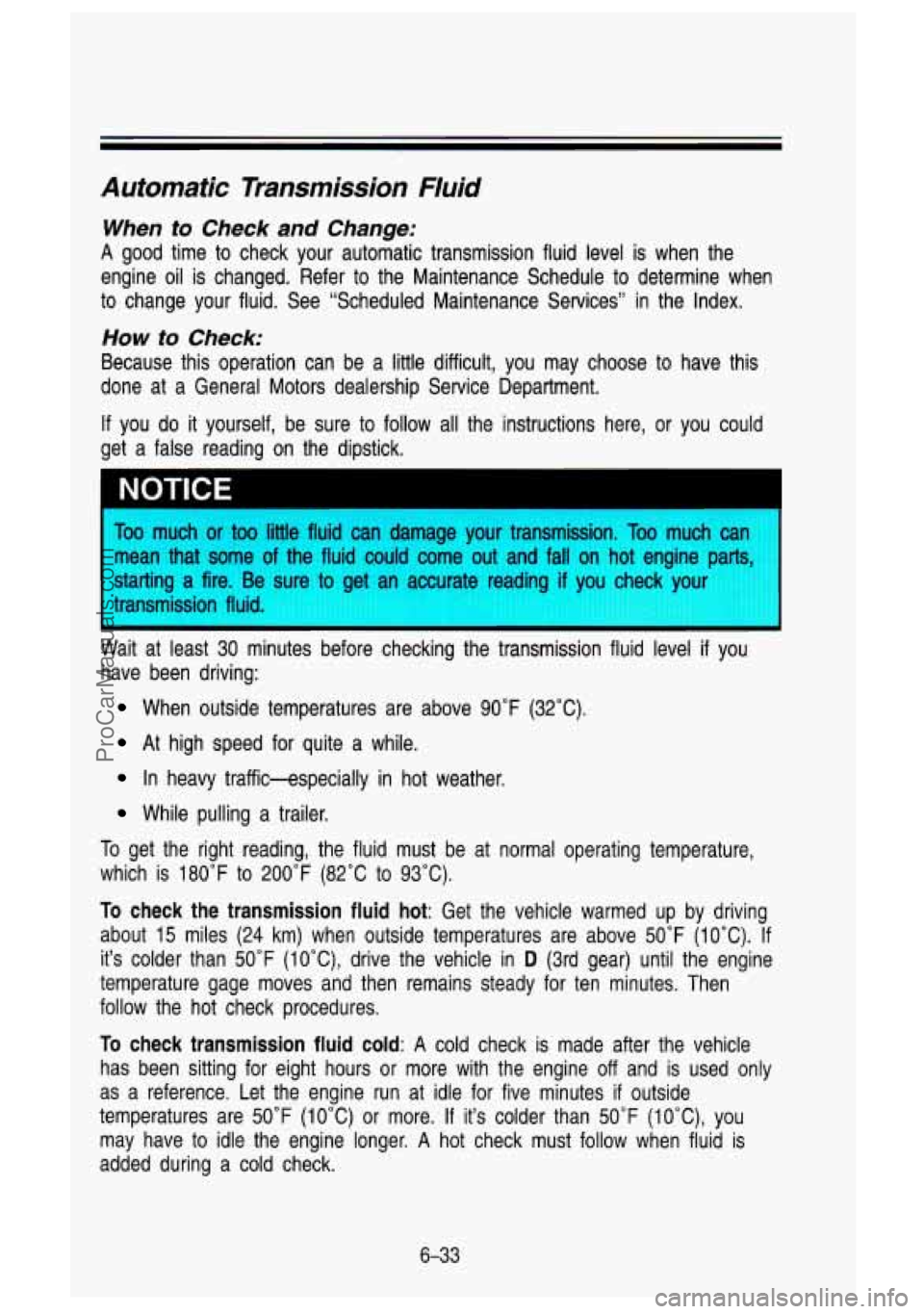
Automatic Transmission Fluid
When to Check and Change:
A good time to check your automatic transmission fluid level is when the
engine oil is changed. Refer
to the Maintenance Schedule to determine when
to change your fluid. See "Scheduled Maintenance Services" in the \
Index.
How to Check:
Because this operation can be a little difficult, you may choose to have this
done at a General Motors dealership Service Department.
If you
do it yourself, be sure to follow all the instructions here, or you could
get a false reading on the dipstick.
I Too much or too little fluid can damage your transmission. Too much can
nean that some of the fluid could come out and fall on hot engine parts,
itarting
a fire. Be sure to get an accurate reading if you check your
ransmission ftuid.
Wait at least
30 minutes before checking the transmission fluid level if you
have been driving:
When outside temperatures are above 90°F (32°C).
At high speed for quite a while.
In heavy traffic-especially in hot weather.
While pulling a trailer.
To get the right reading, the fluid must be at normal operating temperature,
which is 180°F
to 200°F (82°C to 93°C).
To check the transmission fluid hot: Get the vehicle warmed up by driving
about
15 miles (24 km) when outside temperatures are above 50°F (1 0°C). If
it's colder than
50°F (lO°C), drive the vehicle in D (3rd gear) until the engine
temperature gage moves and then remains steady for ten minutes. Then
follow the hot check procedures.
To check transmission fluid cold: A cold check is made after the vehicle
has been sitting for eight hours or more with the engine
off and is used only
as a reference. Let the engine run at idle for five minutes
if outside
temperatures are 50°F (10°C) or more.
If it's colder than 50°F (lO"C), you
may have
to idle the engine longer. A hot check must follow when fluid is
added during a cold check.
6-33
ProCarManuals.com
Page 312 of 436
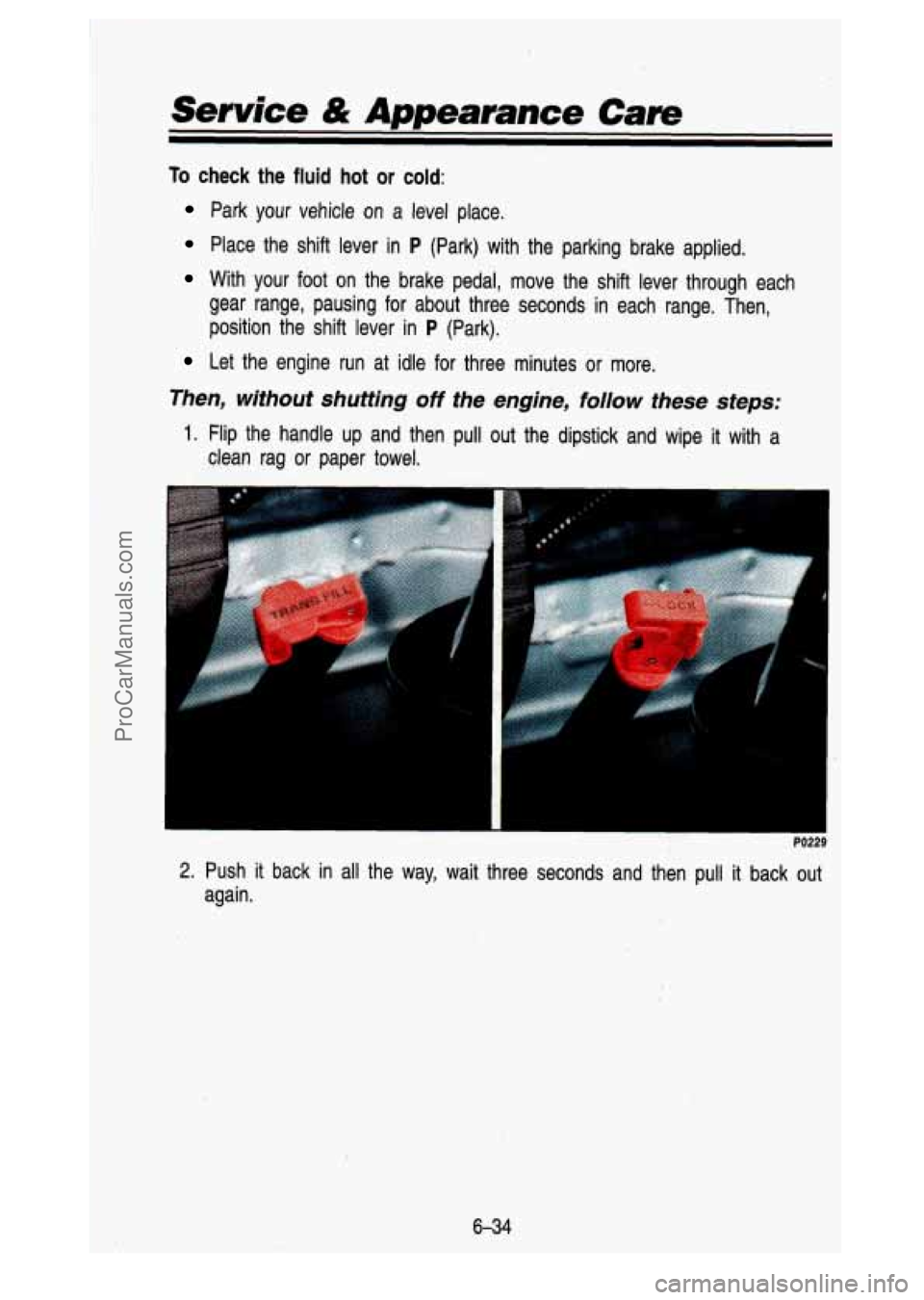
Senrr'ce & bmearance Care
To check the fluid hot or cold:
Park your vehicle on a level place.
Place the shift lever in P (Park) with the parking brake applied.
With your foot on the brake pedal, move the shift lever through each
gear range, pausing for about three seconds in each range. Then,
position the shift lever in
P (Park).
Let the engine run at idle for three minutes or more.
Then, without shutting off the engine, follow these steps:
1. Flip the handle up and then pull out the dipstick and wipe it with a
clean rag or paper towel.
PO229
2. Push it back in all the way, wait three seconds and then pull it back out
again.
634
ProCarManuals.com
Page 313 of 436
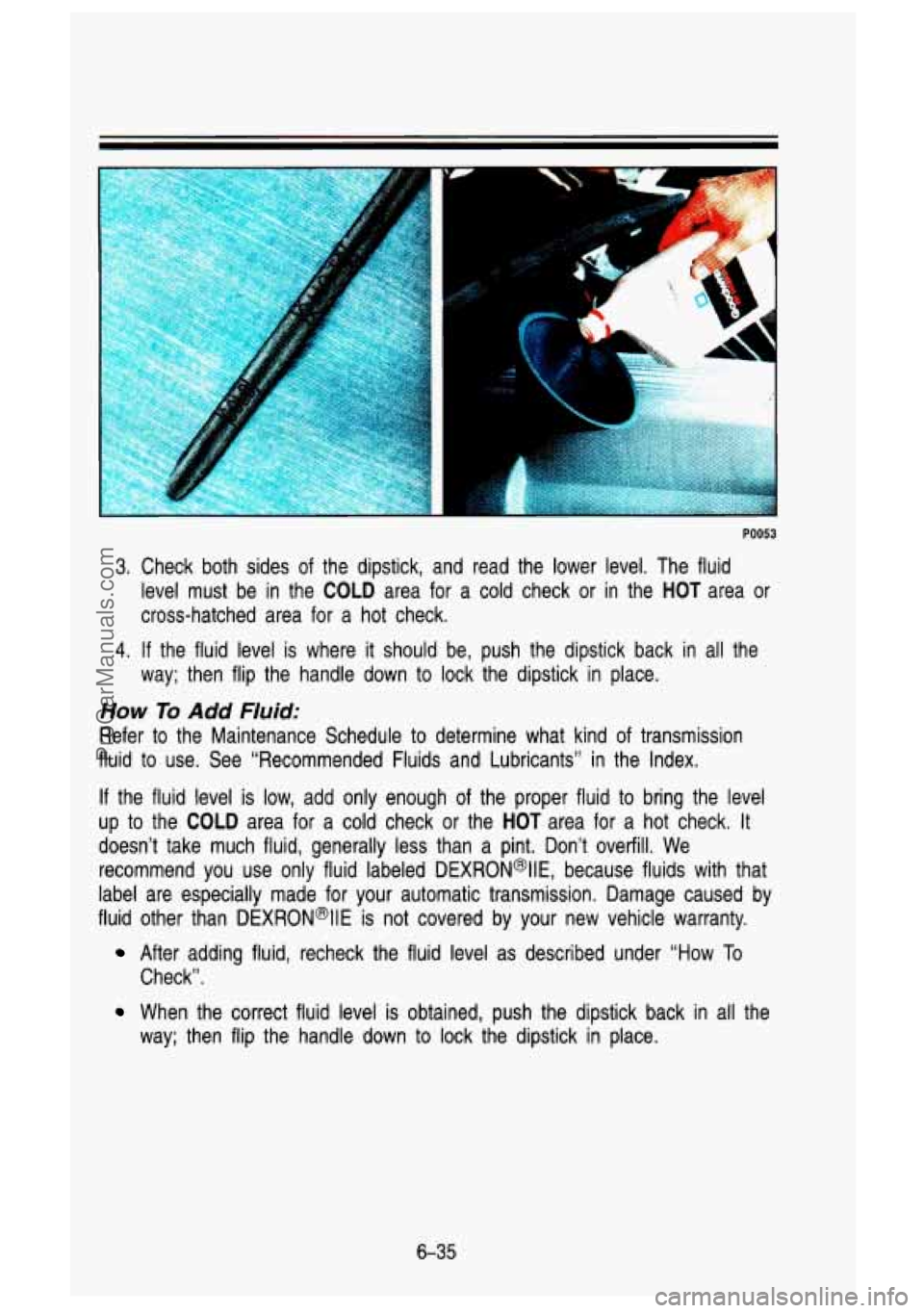
3. Check both sides of the dipstick, and read the lower level. The fluid
level must be in the
COLD area for a cold check or in the HOT area or
cross-hatched area for a hot check.
4. If the fluid level is where it should be, push the dipstick back in all the
way; then flip the handle down to lock the dipstick in place.
How To Add Fluid:
Refer to the Maintenance Schedule to determine what kind of transmission
fluid
to use. See “Recommended Fluids and Lubricants’’ in the Index.
If the fluid level
is low, add only enough of the proper fluid to bring the level
up
to the COLD area for a cold check or the HOT area for a hot check. It
doesn’t take much fluid, generally less than a pint. Don’t overfill. We
recommend you use only fluid labeled DEXRON@IIE, because fluids \
with that
label are especially made for your automatic transmission. Damag\
e caused by
fluid other than
DEXRON@IIE is not covered by your new vehicle warranty.
After adding fluid, recheck the fluid level as described under “How To
Check”.
When the correct fluid level is obtained, push the dipstick back in all the
way; then flip the handle down
to lock the dipstick in place.
6-35
ProCarManuals.com
Page 314 of 436
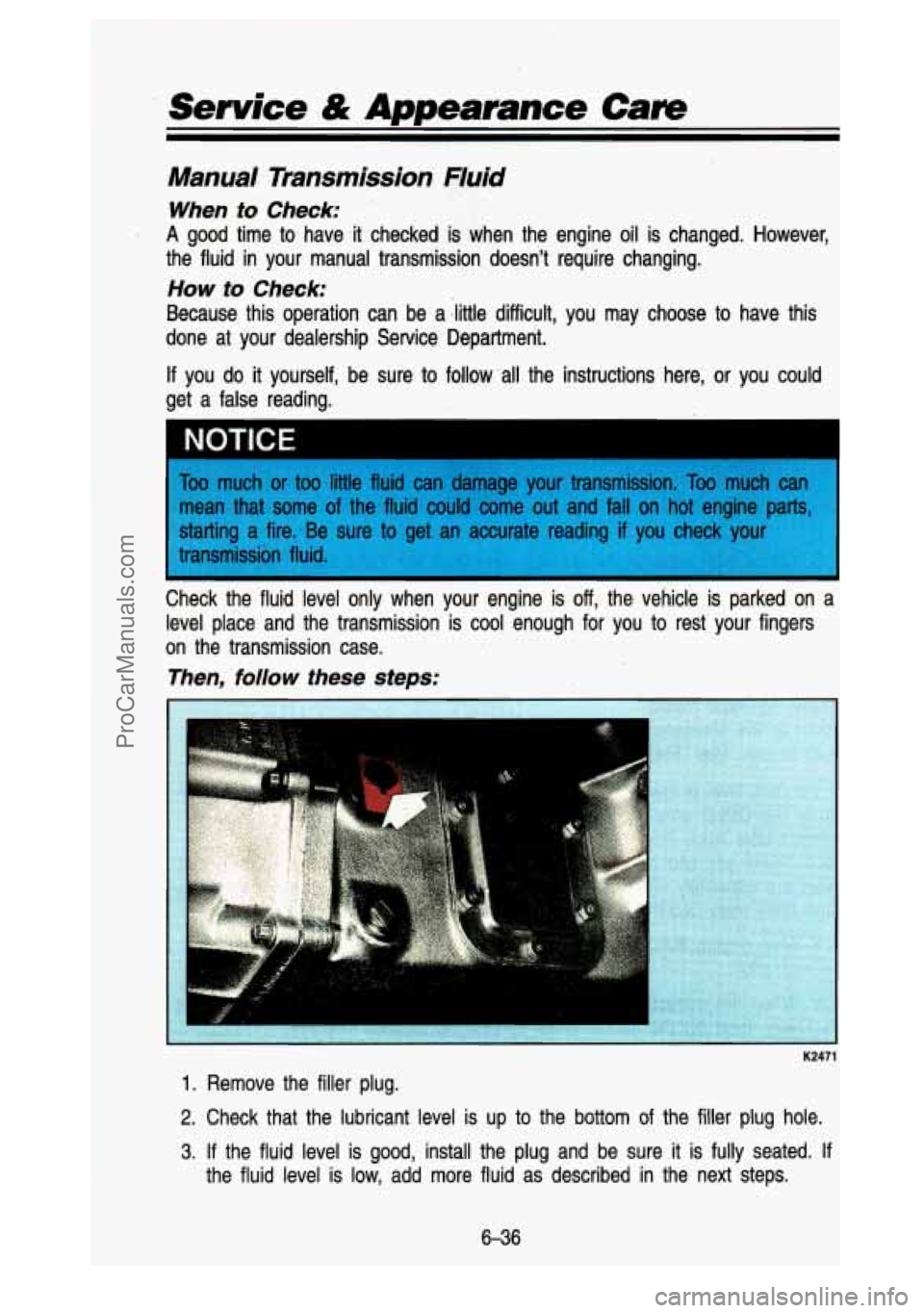
*
Senrice & Appearance Care
Manual Transmission Huld
When to Check:
the fluid in your manual transmission doesn't require changing.
How to 'Check:
Because this operation can be a :little difficult, you may cho\
ose to have this
done at your dealership Service Department.
t A good time to have it checked is when .the engine oil is changed. However,
If you do it yourself, be sure to follow' all the instructions here, or you could
get a false reading..
. . .. . . ... -
Too much or too little fluid can damage your transmission. Too much can
mean that some of the fluid could come out and fall on hot engine parts,
starting a fire. Be sure
to get an accurate reading if you check your
transmission fluid.
Check the fluid level only when your engine is
off, the vehicle is parked on a
level place and the transmission is cool enough for you to re\
st your fingers
on the transmission case.
Then, follow these steps:.
~ ~~ ~
1. Remove the filler plug.
K2471
2. Check that the lubricant level is up to the bottom of the filler- plug hole.
3. If the fluid level is good, install the plug and be sure it is fully seated. If
the fluid level is low, add more fluid as described in the next steps.
6-36
ProCarManuals.com
Page 315 of 436
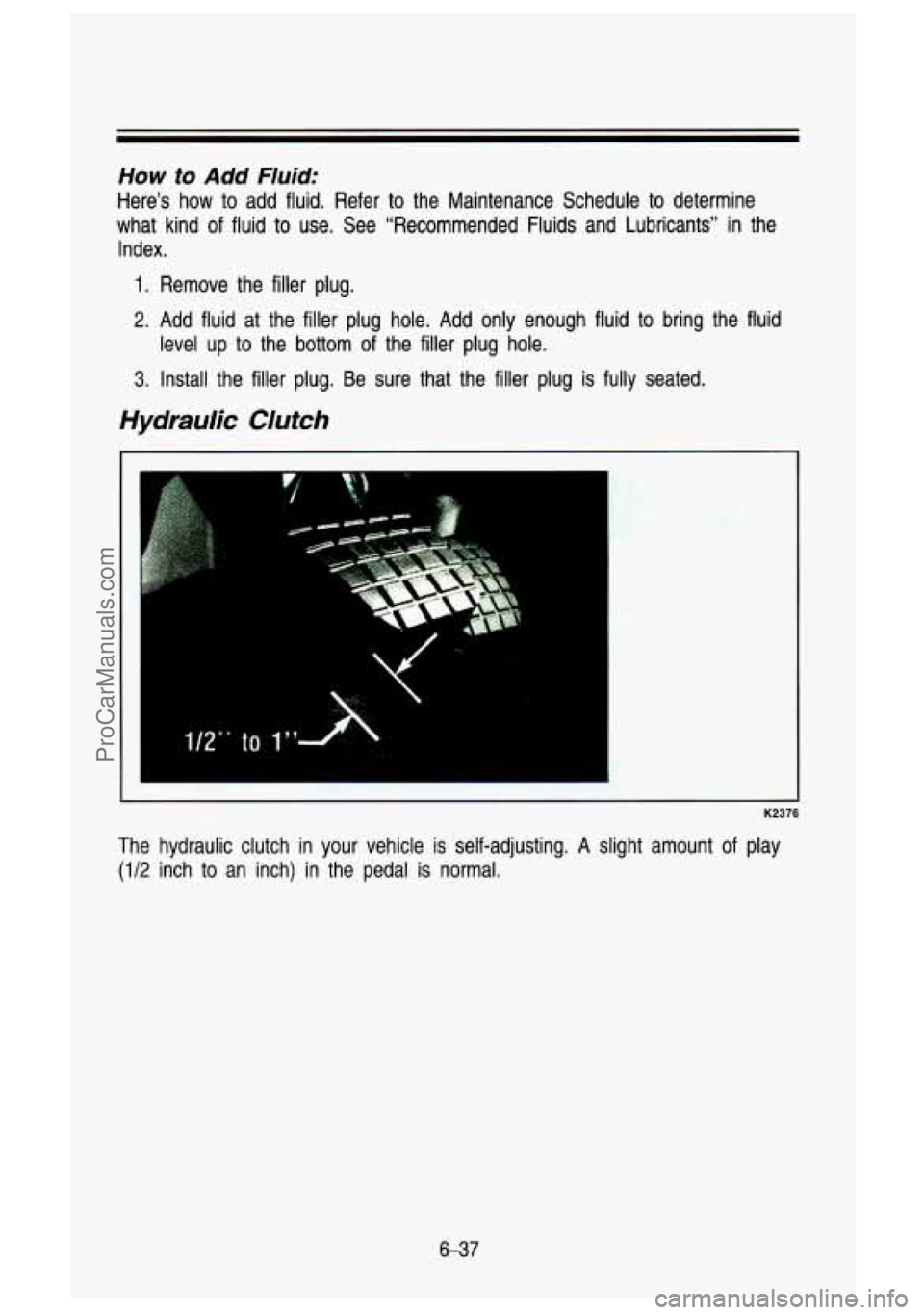
How to Add Fluid:
Here’s how to add fluid. Refer to the Maintenance Schedule to determine
what kind of fluid to use. See “Recommended Fluids and Lubricants” in the
Index.
1. Remove the filler plug.
2. Add fluid at the filler plug hole. Add only enough fluid to \
bring the fluid
3. Install the filler plug. Be sure that the filler plug is full\
y seated.
level up
to the bottom
of the filler plug hole.
Hydraulic Clutch
112” to
K2376
The hydraulic clutch in your vehicle is self-adjusting. A slight amount of play
(112 inch to an inch) in the pedal is normal.
6-37
ProCarManuals.com
Page 316 of 436
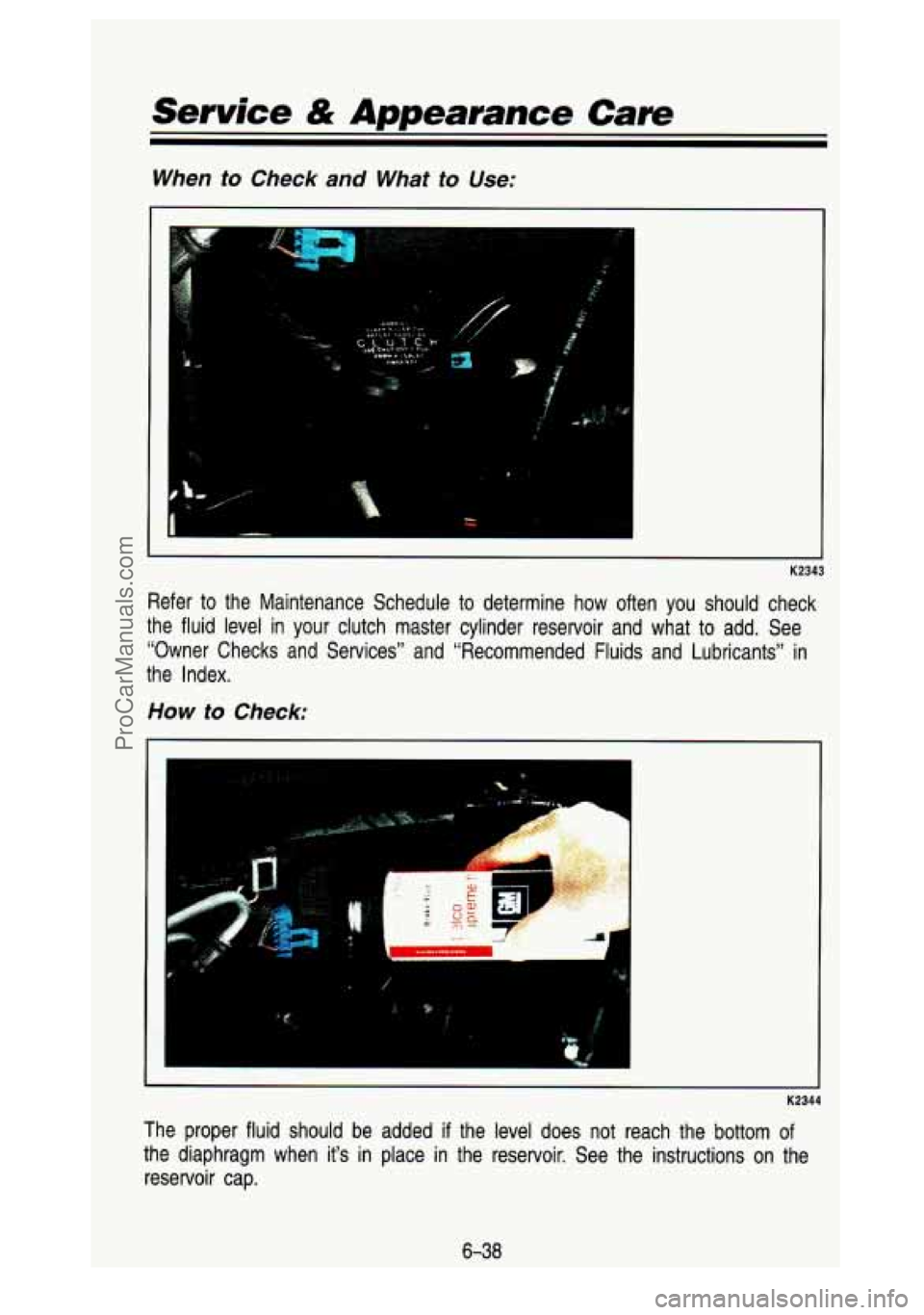
Service & Amearance Care
-
When to Check and What to Use;
Refer to the Maintenance Schedule to determine how often you should check
the fluid level in your clutch master cylinder reservoir and what to add. See
“Owner Checks and Services” and “Recommended Fluids and \
Lubricants” in
the Index.
How to Check:
K2344
The proper fluid should be added if the level does not reach the bottom of
the diaphragm when it’s in place in the reservoir. See the instructions on the
reservoir cap.
6-38
ProCarManuals.com
Page 317 of 436
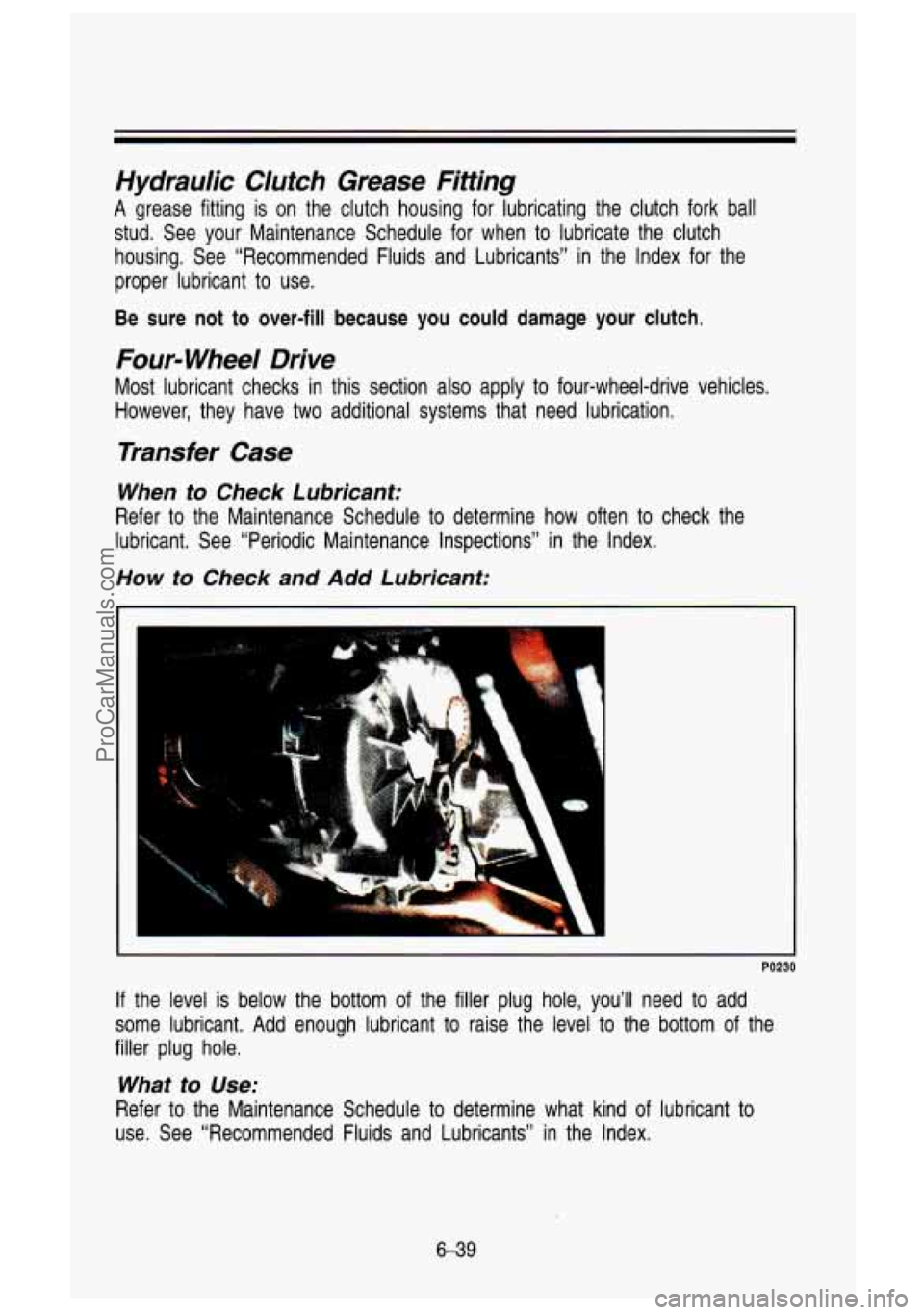
Hydraulic Clutch Grease Fitting
A grease fitting is on the clutch housing for lubricating the clutch fork ball
stud. See your Maintenance Schedule for when to lubricate the clutch
housing. See “Recommended Fluids and Lubricants” in the Index for the
proper lubricant to use.
Be sure not to over-fill because you could damage your clutch.
Four- Wheel Drive
Most lubricant checks in this section also apply to four-wheel-drive vehicles.
However, they have two additional systems that need lubrication.
Transfer Case
When to Check Lubricant:
Refer to the Maintenance Schedule to determine how often to check the
lubricant. See “Periodic Maintenance Inspections” in the Index.
How to Check and Add Lubricant:
I
PO230
If the level is below the bottom of the filler plug hole, you’ll need to add
some lubricant. Add enough lubricant to raise the level to the bottom of the
filler plug hole.
What to Use:
Refer to the Maintenance Schedule to determine what kind of lubricant to
use. See “Recommended Fluids and Lubricants” in the Index.
639
ProCarManuals.com
Page 318 of 436
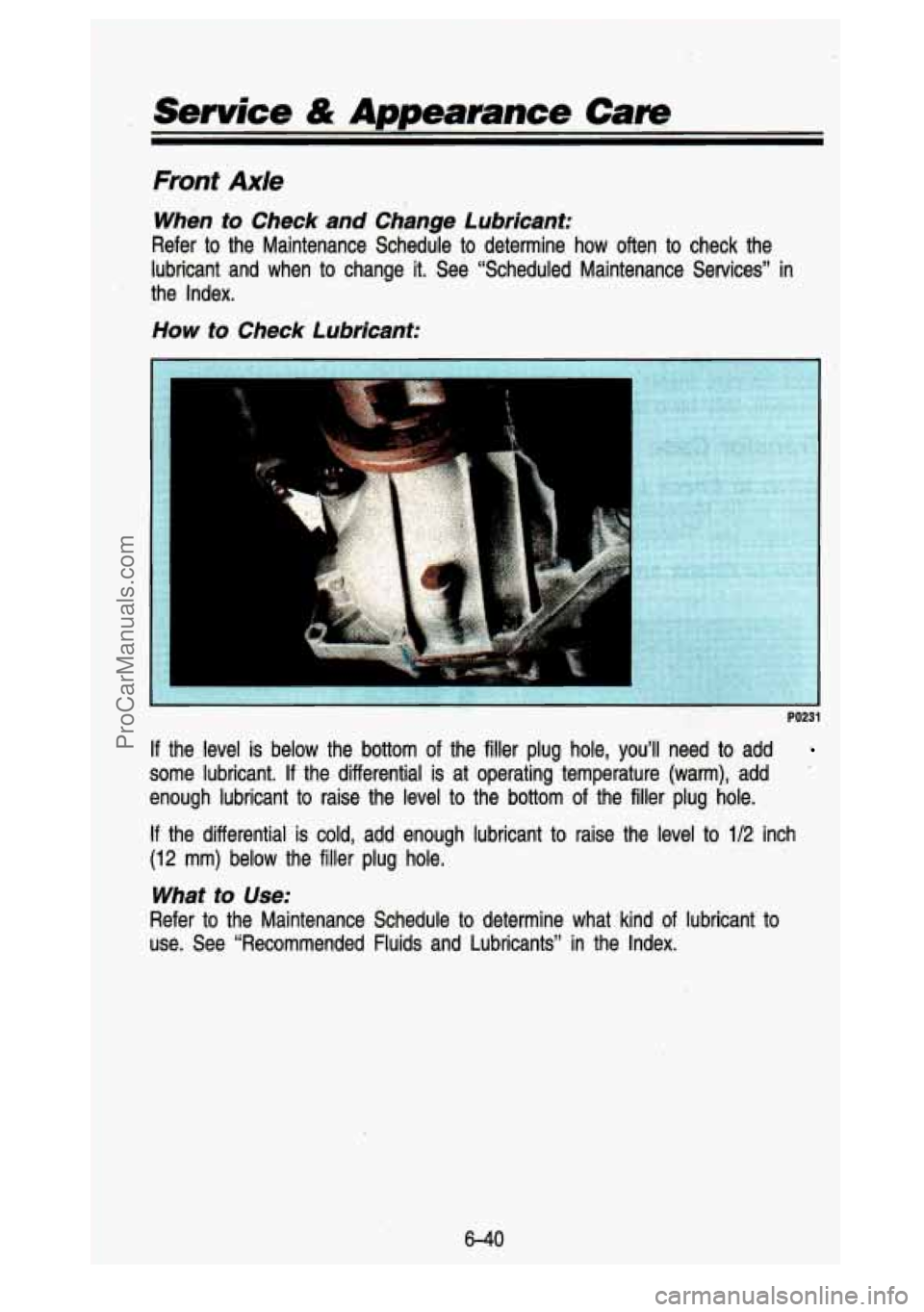
Senrice d& Appearance Cam
Front Axle
When to Check and Change Lubricant:
Refer to the Maintenance Sched,ule to determine
lubricant and when to change it. See “Scheduled
the Index.
How to Check Lubricant:
how often to check the Maintenance Services” in
PO231
If the. level is below the bottom of the filler plug hole, you’ll need to add
some lubricant. If the differential is at operating temperature (warm), add
enough lubricant to raise the level to the bottom
of the filler plug hole.
If the differential is cold, add, enough lubricant to raise the level to 1/2 inch
(12 mm) below the filler plug hole.
What to Use:
Refer to the Maintenance Schedule to determine what .kind of lubricant to
use. See “Recommended Fluids and Lubricants’’ in the Index.
- 1‘
6-40
. . .,.
c
-
...
ProCarManuals.com
Page 319 of 436
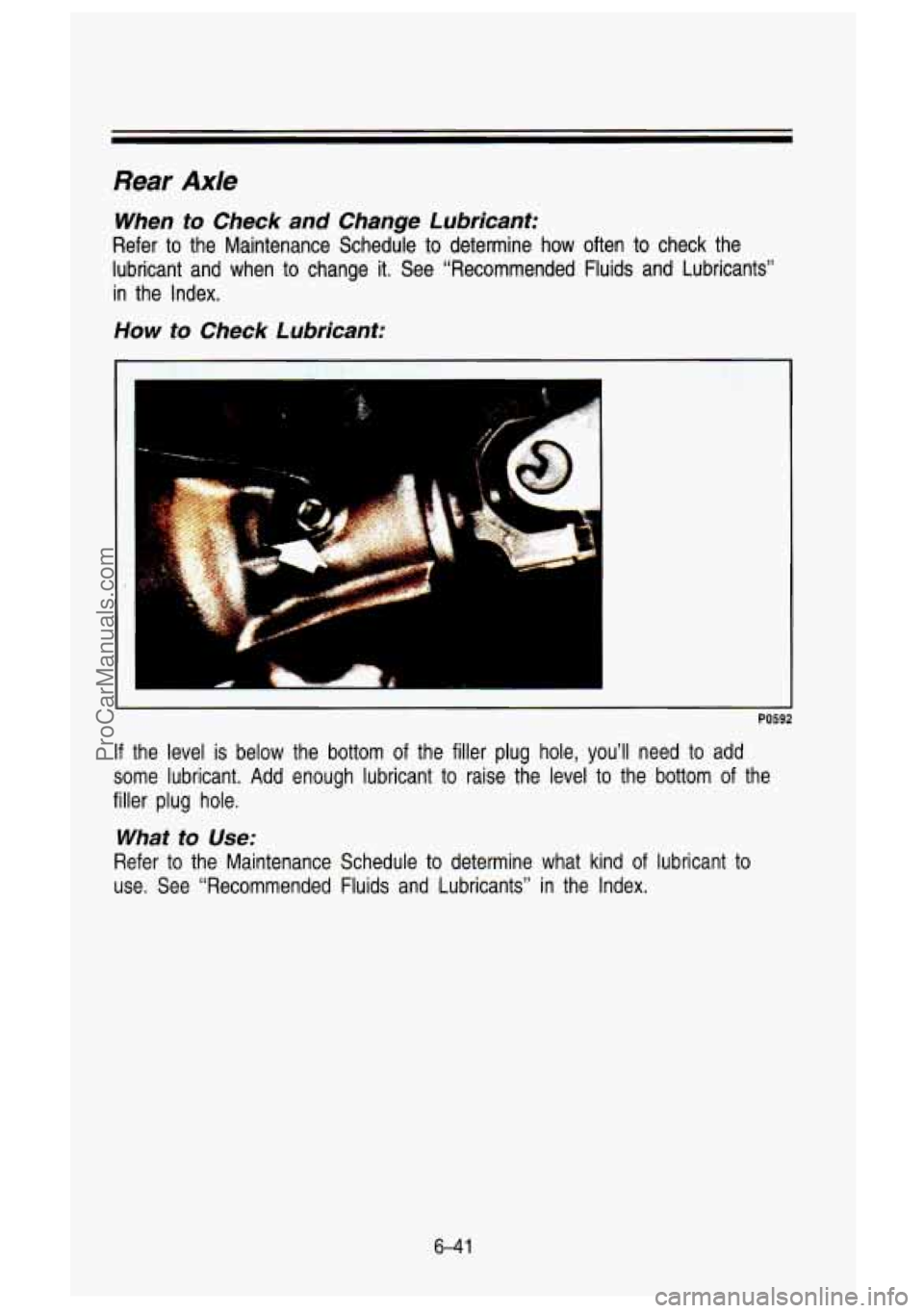
Rear Axle
When to Check and Change Lubricant:
Refer to the Maintenance Schedule to determine how often to check the
lubricant and when to change it. See “Recommended Fluids and Lubricants”
in the Index.
How to Check iubricant:
L
PO592
If the level is below the bottom of the filler plug hole, you’ll need to add
some lubricant. Add enough lubricant
to raise the level to the bottom of the
filler plug hole.
What to Use:
Refer to the Maintenance Schedule to determine what kind of lubricant to
use. See “Recommended Fluids and Lubricants” in the Index.
6-41
ProCarManuals.com
Page 320 of 436
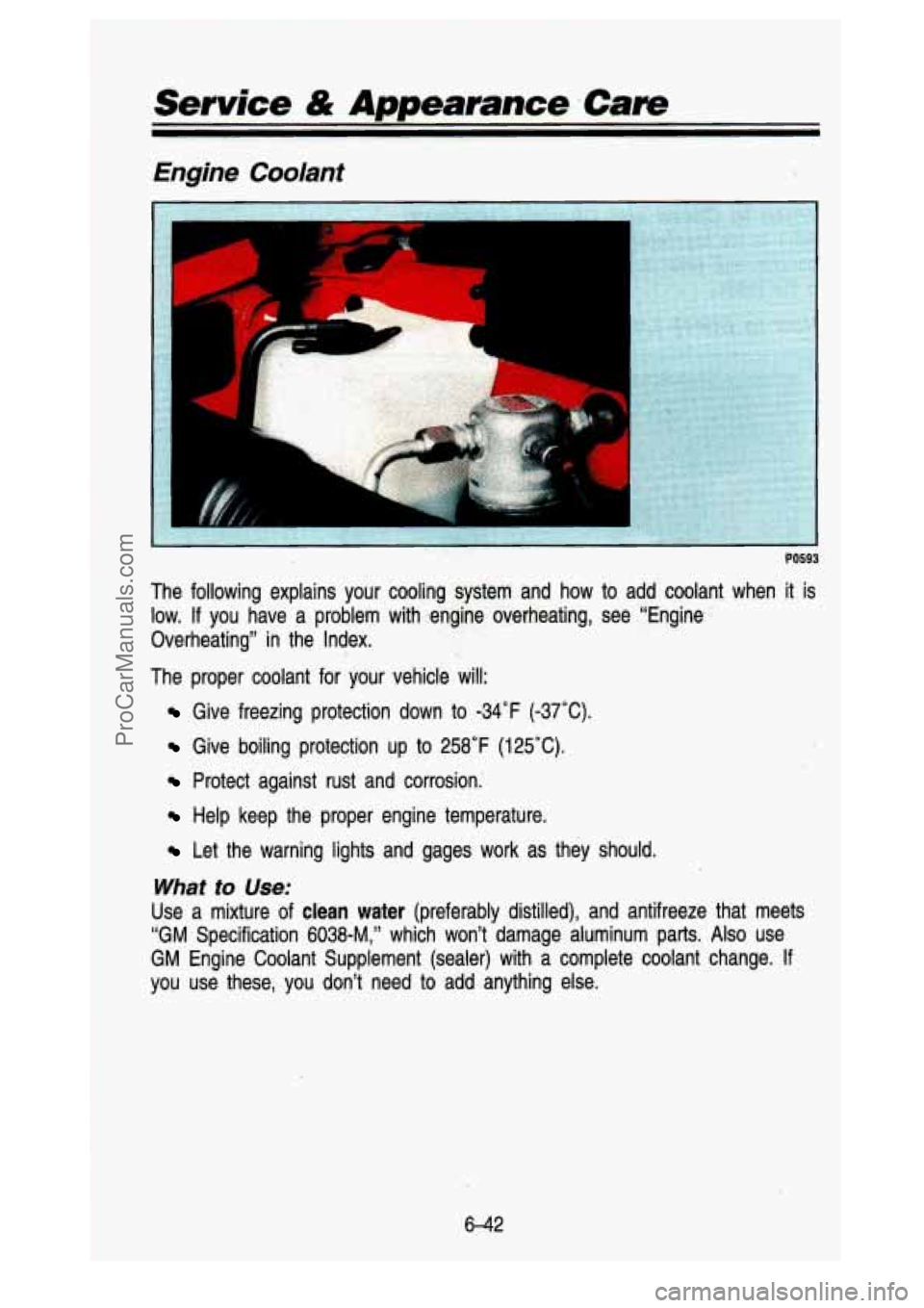
Service & Appearance ,Care
Engine Coolant
r
PO593
The following explains your cooling system and how to add cool\
ant when it is low.
If you have a problem with -engine overheating, see “Engine
Overheating” in the Index.
The proper coolant for your vehicle will:
Give freezing protection down to -34°F (-37°C).
Give boiling protection up to 258°F (125°C).
Protect against rust and corrosion:
Help keep the proper engine temperature.
Let the warning lights and gages work as thiy should.
What to Use:
Use a ,mixture of clean water (preferably distilled), and antifreeze that meets
“GM Specification 6038-M,” which won’t damage aluminum p\
arts.
Also use
GM Engine Coolant Supplement (sealer) with a complete coolant change. If
you use these, you don’t need to add anything else.
,
6-42
ProCarManuals.com